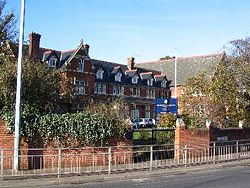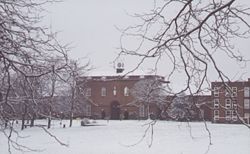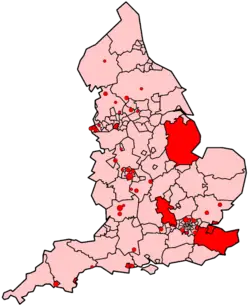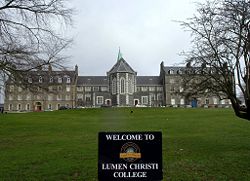Grammar school
| Schools |
|---|
| Education |
| History of education |
| Pedagogy |
| Teaching |
| Homeschooling |
| Preschool education |
| Child care center |
| Kindergarten |
| Primary education |
| Elementary school |
| Secondary education |
| Middle school |
| Comprehensive school |
| Grammar school |
| Gymnasium |
| High school |
| Preparatory school |
| Public school |
| Tertiary education |
| College |
| Community college |
| Liberal arts college |
| University |
A grammar school, a term most often used in the United Kingdom and Australia, is a secondary school, in which college preparatory subjects, such as Latin and Greek, are emphasized. Students usually begin attendance at age 12, for many years based on successful scores on the Eleven plus exam.
The grammar school was instituted in Britain as part of the publicly funded educational system at the beginning of the twentieth century, which aimed to provide free compulsory education for all children. For secondary education, the nature of the program depended on the child, with the intention being to provide education appropriate to their needs and abilities. While some continue to support the idea of selective education, with the academically gifted (at age eleven) receiving education appropriate for tertiary education at the university level while others receive vocational education or a general education, for many this system is regarded as elitist and unfair. Reform of the system in the latter part of the twentieth century, introducing the comprehensive school for all students, closed the majority of grammar schools, and unfortunately the standard of secondary education dropped significantly. While the grammar school as originally envisioned may no longer have a place in contemporary society, the ideals of appropriate and high standard education for all children are essential to the health of future societies. Finding the way to offer such education to all is the challenge that still needs to be met.
History
In medieval times, the importance of Latin in government and religion meant there was a strong demand to learn the language. Schools were set up to teach the basis of Latin grammar, calling themselves "grammar schools." Pupils were usually educated up to the age of 14, after which they would look to universities and the church for further study.
Teaching usually took place from dawn to dusk, and focused heavily upon the rote learning of Latin. It would be several years before pupils were able to construct a sentence, and they would be in their final years at the school when they began translating passages. In order to encourage fluency, some schoolmasters recommended punishing any pupil who spoke in English. By the end of their studies, they would be quite familiar with the great Latin authors, as well as the studies of drama and rhetoric.[1]
Other skills, such as numeracy and handwriting, were neglected, being taught in odd moments or by traveling specialist teachers such as scriveners. Little attention was given to other classical languages, such as Greek, due to a shortage of non-Latin type and of teachers fluent in the language.
The first of these grammar schools appeared in Anglo-Saxon times, but the majority of them were founded after the fifteenth century. Significantly, these schools were often separate from the church, unlike cathedral schools, and hence survived the Reformation. Some new schools were founded and other schools which were associated with the church were re-founded with the proceeds of the dissolution of the monasteries by Henry VIII.[2]
In the absence of civic authorities, grammar schools were established as acts of charity, either by private benefactors or corporate bodies such as guilds. Many of these are still commemorated in annual "Founder's Day" services and ceremonies at surviving schools. Edward VI also made an important contribution to grammar schools, founding a series of schools during his reign, known as King Edward's Schools, and James I founded a series of "Royal Schools" in Ulster, beginning with The Royal School, Armagh. In spite of these donations, the schools relied on fees paid by the students.
Victorian grammar schools
The revolution in civic government that took place in the late nineteenth century created a new breed of grammar schools. After the Endowed Schools Act 1869, it became markedly easier to set up a school. At the time, there was a great emphasis on the importance of self-improvement, and parents keen for their children to receive a good education took a lead in organizing the creation of new schools.[3] Many took the title "grammar school" for historical reasons.
Grammar schools thus emerged as one part of the highly varied education system of England, Wales, and Northern Ireland before 1944. These newer schools tended to emulate the great public schools, copying their curriculum, ethos, and ambitions. Many schools also adopted the idea of entrance exams and scholarships for poorer students. This meant that they offered able children from poor backgrounds an opportunity for a good education.[2]
Grammar schools in the Tripartite System
The 1944, Butler Education Act created the first nationwide system of secondary education in England and Wales.[4] It was echoed by the Education (Northern Ireland) Act 1947. Three types of schools were planned, one of which was the grammar school, the other two being the Secondary modern school and the Technical school. Intended to teach an academic curriculum to intellectually able children who did well in their eleven plus examination, the grammar school soon established itself as the highest tier in the Tripartite System.
Two types of grammar school existed under the system. The larger group was fully state funded. They emulated the older grammar schools and sought to replicate the studious, aspirational atmosphere found in such establishments. Most were either newly created or built since the Victorian period.
In addition to those run fully by the state, there were 179 Direct Grant Grammar Schools. These took between one quarter and one half of their pupils from the state system, and the rest from fee-paying parents. They also exercised far greater freedom from local authorities, and were members of the Headmasters' Conference. These schools included some very old schools, encouraged to partake in the Tripartite System, and achieved the best academic results of any state schools. The most famous example of a Direct Grant Grammar was Manchester Grammar School, whose headmaster, Lord James of Rusholme, was one of the most outspoken advocates of the Tripartite System.
Grammar school pupils were given the best opportunities of any schoolchildren. Initially, they studied for the School Certificate and Higher School Certificate, replaced in 1951, by General Certificate of Education examinations at O-level (Ordinary level) and A-level (Advanced level). In contrast, very few students at secondary modern schools took public examinations until the introduction of the less academic Certificate of Secondary Education (known as the CSE) in the 1960s.[5] Grammar schools possessed better facilities and received more funding than their secondary modern counterparts. Until the implementation of the Robbins Report in the 1960s, children from public and grammar schools effectively monopolized access to university. These schools were also the only ones that offered an extra term of school to prepare pupils for the competitive entrance exams for "Oxbridge"—Oxford and Cambridge universities.
Abolition of the Tripartite System
The Tripartite System was largely abolished in England and Wales in the decade between 1965, with the issue of Circular 10/65, and the 1976 Education Act. Most grammar schools were amalgamated with a number of other local schools, to form neighborhood Comprehensive schools, although a few were closed. This process proceeded quickly in Wales, with the closure of such schools as Cowbridge Grammar School. In England, implementation was more uneven, with some counties and individual schools resisting the change.[6]
Direct Grant Grammar Schools almost invariably severed their ties with the state sector, and became fully independent. There are thus many schools with the name "grammar," but which are not free. These schools normally select their pupils by an entrance examination and, sometimes, an interview. While many former grammar schools ceased to be selective, some of them retained the word "grammar" in their name. Most of these schools remain comprehensive, while a few became partially selective or fully selective in the 1990s.
The debate about the British Tripartite System continued years after its abolition was initiated, and evolved into a debate about the pros and cons of selective education in general.
Supporters of the grammar school system contend that bright children from poor backgrounds were far better served by the Tripartite System. The Comprehensive System was created with the intention of offering a grammar school-quality education at all levels, but this never materialized. With increasing concern about levels of classroom discipline, it is argued that comprehensive schools can foster an environment that is not conducive to academic achievement.[7] Bright children can suffer bullying for doing well at school, and have to justify their performance to their social group.[7] The grammar school, catering exclusively to the more able, is thus seen as providing a safer environment in which such children can attain academic success.
Many opponents of the Tripartite System argue that the grammar school was antithetical to social leveling.[7] A system that splits the population into the intelligent and the unintelligent based on a test at the age of 11 does not aid social integration. The tripartite system gave an extremely important role to the eleven plus. Those who passed were seen as successes, while those that failed were stigmatized as second class pupils. The merits of testing at age eleven, when children were at varying stages of maturity, has been questioned, particularly when the impact of the test on later life is taken into account. Children who developed later (so-called "late bloomers") suffered because there was inflexibility in the system to move them between grammar and secondary modern schools. Once a child had been allocated to one type of school or the other it was extremely difficult to have this assessment changed.
One reason the debate over selective education, or the "grammar school debate," continued for so long is that it reflects important differences in views about equality and achievement. The effort to establish comprehensive schools, following the vision of those such as Anthony Crosland to end selectivity, failed to produce a successful educational system for all. Yet, for many,
The comprehensive ideal remains powerful. The belief that drove politicians like Crosland should drive us now. It is a passion that all children, from whatever background, are alike in their capacity to reason, to imagine, to aspire to a successful life. In the 60s this meant rejecting the flawed science and injustice of the 11-plus and it meant radical surgery for a system in which children's futures were, in large part, decided on one day when they were 11.[8]
The failure of the comprehensive system can be argued as more a failure of implementation than a wrong direction:
There was little agreement on what it meant to provide a high-quality education once children were inside the school gate. Schools tended to take on a single model, with little scope for developing distinctive character or mission. The creation of "good" middle-class and "bad" working-class comprehensive schools was not predicted. And parents and pupils were not at the heart of reform.[8]
In March 2000, the Education Secretary David Blunkett sought to close down the debate by saying "I'm desperately trying to avoid the whole debate in education concentrating on the issue of selection when it should be concentrating on the raising of standards. Arguments about selection are a past agenda."[9]
Contemporary grammar schools
By the 1980s, all of the grammar schools in Wales and most of those in England had closed or become comprehensive. Selection also disappeared from state-funded schools in Scotland in the same period.
England
In the early years of the twenty-first century, there were still 164 state-run grammar schools in existence in England.[10] Only a few areas keep a formal grammar school system along the lines of the Tripartite System. In these areas, the eleven plus exam is used solely to identify a subset of children (around 25 percent) considered suitable for grammar education. When a grammar school has too many qualified applicants, other criteria are used to allocate places, such as siblings, distance or faith. Such systems still exist in Buckinghamshire, Rugby and Stratford districts of Warwickshire, the Salisbury district of Wiltshire, Stroud in Gloucestershire, and most of Lincolnshire, Kent and Medway. Of metropolitan areas, Trafford and most of Wirral are selective.[11]
In other areas, grammar schools survive mainly as very highly selective schools in an otherwise comprehensive county, for example in several of the outer boroughs of London. In some LEAs, as few as two percent of 11 year olds may attend grammar schools. These schools are often heavily over-subscribed, and award places in rank order of performance in their entry tests. They also tend to dominate the top positions in performance tables.[12]
Since 1997, successive Education Secretaries have expressed support for an increase in selective education along the lines of old grammar schools. Specialist schools, advanced schools, beacon schools, and similar initiatives have been proposed as ways of raising standards, either offering the chance to impose selection or recognizing the achievements of selective schools.
Northern Ireland
Attempts to move to a comprehensive system (as in the rest of the United Kingdom) have been delayed by shifts in the administration of the province. As a result, Northern Ireland still maintains the grammar school system with most pupils being entered for the Eleven plus. Since the "open enrollment" reform of 1989, these schools (unlike those in England) have been required to accept pupils up to their capacity, which has also increased.[13]
By 2006, the 69 grammar schools took 42 percent of transferring children, and only 7 of them took all of their intake from the top 30 percent of the cohort.[14]
With the end of the eleven plus, a proposed new transfer point at age 14, with specialization of schools beyond that point, may offer a future role for grammar schools. Alternatively, a consortium of 25 grammar schools could run a common entry test for admissions, while others, such as Lumen Christi College, the top-ranking Catholic school, have plans to run their own tests.[15]
Australia
In Australia, "grammar schools" are generally high-cost Anglican Church of Australia schools, public schools in the sense of the Associated Public Schools of Victoria and the Associated Grammar Schools of Victoria. Those using the term "grammar" in their title are often the oldest Anglican school in their area. Examples of these include such schools as Camberwell Grammar School (1886), Caulfield Grammar School (1881), Geelong Grammar School (1855), and Melbourne Grammar School (1858). The equivalent of the English grammar schools are known as selective schools.
Hong Kong
Hong Kong developed its Secondary education largely based on the English schooling system, with single-sex education being widespread. Secondary schools primarily offering a traditional curriculum (instead of vocational subjects) were thus called grammar schools.
Notes
- ↑ The Guild School Association (2003), Educating Shakespeare. Retrieved May 15, 2008.
- ↑ 2.0 2.1 Will Spens (1938), Secondary education with special reference to grammar schools and technical high schools, HM Stationery Office, London. Retrieved May 25, 2008.
- ↑ Peter Gordon, "Some Sources for the History of the Endowed Schools Commission, 1869-1900" British Journal of Educational Studies 14 (3).
- ↑ J.R. Hough, The Education System in England and Wales: A Synopsis (Loughborough University Press, 1991, ISBN 0946348065).
- ↑ Qualifications and Curriculum Authority, The story of the General Certificate of Secondary Education (GCSE). Retrieved May 15, 2008 .
- ↑ Jörn-Steffen Pischke and Alan Manning, Comprehensive versus Selective Schooling in England in Wales: What Do We Know? Working Paper, April 2006.
- ↑ 7.0 7.1 7.2 Kate Jackson, Grammar school debate: Are Grammar Schools Better? BBC Kent. Retrieved May 20, 2008.
- ↑ 8.0 8.1 Ruth Kelly, Beyond Crosland's vision, The Guardian, Wednesday March 30, 2005. Retrieved May 20, 2008.
- ↑ BBC News, Grammar debate is a "past agenda." Retrieved May 20, 2008.
- ↑ UK Parlaiment Publications and Records, House of Commons Hansard, 16 July 2007: Columns 104W-107W. Retrieved May 19, 2008.
- ↑ David Jesson, The Comparative Evaluation of GCSE Value-Added Performance by Type of School and LEA. Retrieved March 19, 2008.
- ↑ Sian Griffiths, Grammars show they can compete with best, Sunday Times. Retrieved May 25, 2008.
- ↑ Eric Maurin and Sandra McNally, Educational Effects of Widening Access to the Academic Track: A Natural Experiment. Retrieved April 4, 2008.
- ↑ Caitriona Ruane, Education Minister's Statement for the Stormont Education Committee. Retrieved April 4, 2008.
- ↑ Lisa Smith, "Test" schools accept D grade pupils. Retrieved May 25, 2008.
ReferencesISBN links support NWE through referral fees
- Carlisle, Nicholas. A Concise Description of the Endowed Grammar Schools in England and Wales. Thoemmes Continuum, 2002. ISBN 978-1855069565.
- Curtis, Polly. Grammar schools fuelling social segregation, academics find. The Guardian (Friday February 1 2008). Retrieved May 25, 2008.
- Hough, J.R. The Education System in England and Wales: A Synopsis. Loughborough University Press, 1991. ISBN 0946348065.
- Naylor, Fred, and Roger Peach. The Truth About Grammar Schools. National Grammar Schools Association, 2005.
External links
All links retrieved May 25, 2008.
- Grammar schools have expanded
- National Grammar Schools Association
- Q and A: Advanced schools An article on advanced schools and other advanced sections of the English secondary system.
- Campaign for State Education
- Campaign for Fair Admissions
Credits
New World Encyclopedia writers and editors rewrote and completed the Wikipedia article in accordance with New World Encyclopedia standards. This article abides by terms of the Creative Commons CC-by-sa 3.0 License (CC-by-sa), which may be used and disseminated with proper attribution. Credit is due under the terms of this license that can reference both the New World Encyclopedia contributors and the selfless volunteer contributors of the Wikimedia Foundation. To cite this article click here for a list of acceptable citing formats.The history of earlier contributions by wikipedians is accessible to researchers here:
- Grammar_school history
- Grammar_schools_in_the_United_Kingdom history
- Debates_on_the_grammar_school history
The history of this article since it was imported to New World Encyclopedia:
Note: Some restrictions may apply to use of individual images which are separately licensed.




